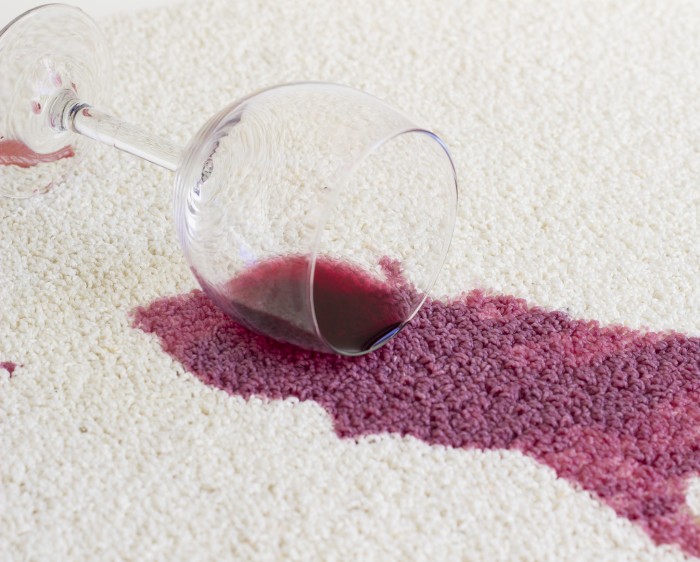Oxidizers and reducers

Bleaches fall into two categories: Oxidizers and reducers.
These can be useful in removing a wide variety of stains. To use them effectively, it helps to understand how they work.
The typical carpet cleaner thinks of oxidation and reduction differently from the chemist.
This article will try to narrow that gap without rising to the complexity of a college chemistry course.
The first order of business is to figure out why a bleaching agent can aid in the stain removal process.
Why is the sky blue?
The answer to this question illustrates why oxidizers and reducers may render a stain colorless.
A clear daytime sky is blue because molecules in the air scatter blue light more than other colors.
At sunset, we may look toward the sun and see red and orange, colors that have not been scattered but travel to our eyes in a straight line.
Blues and other colors have been scattered. Those scattered blue rays are what reach our eyes when we are not looking directly toward the sun.
You can demonstrate this as John Tyndall did in 1859 by shining a light through a clear liquid in which small particles were held in suspension.
A little milk or soap in the water provides the small particles. Viewed from the side, the light appeared blue. Viewed from the end, the light looked red.
Tyndall and others thought the light was being scattered by dust particles or water vapor.
Later, it was shown that it was actually molecules of oxygen and nitrogen, the most common elements in our atmosphere, doing the scattering.
We see things as different colors because the structure of the molecules affects what light is absorbed, reflected, scattered or passed through.
The portion of the molecule that determines the color is called a chromophore. If we alter the chromophore, we change the color.
So, when oxidizers and reducers react with a molecule, it can be changed to something that allows light to pass through unaltered.
The stain has become colorless!
Chemical reaction
In simple terms, reducers remove oxygen from a molecule while oxidizers add oxygen. This change makes the stain colorless.
Some stains that appear to have been removed, when viewed under normal lighting, may be visible when viewed under UV light.
Sometimes, this chemical action can be reversed. Staining material that was reduced may recombine with oxygen and the stain reappears.
Oxidizing agents and reducers can lose potency by reacting with the atmosphere. Heat will accelerate this loss of potency.
It is important to keep these products sealed and away from heat to the extent practical. Manufacturers of stain removal products that contain bleaches may package them in powder form to help slow down the deterioration.
For liquid reducers and oxidizers, it is helpful to store them in an insulated spotting kit and carry no more than you need for each days’ use in your van.
Additional supplies can be kept back in your shop or garage at more moderate temperatures. Placing a reusable block of “blue ice” in the spotting kit each day is a great way to extend the shelf life of your products.
When to use bleaches
These are potent chemicals.
When improperly used, bleaches may corrode metal, remove colors that you did not want to remove or degrade natural fibers such as wool, cotton and silk.
They should be used after you have removed as much of the staining material as possible by other means.
Older stains that have “set” or had time to bond with the fibers will be more difficult to remove and more likely to require bleach.
When you do apply an oxidizer or reducer, make sure other chemical agents have been flushed from the fiber.
The presence of other chemicals may unexpectedly inhibit or accelerate the action of your spotter.
Get the carpet as dry as you can before applying the oxidizer or reducer. A fiber that is full of moisture will not readily absorb your spotting agent. That moisture also dilutes your stain remover.
Oxidizers
Chlorine bleach (laundry bleach) — chemically known as sodium hypochlorite — works very quickly and can result in unintended color loss, dissolving wool fibers or corroding metal.
Be very careful if you choose to use this product.
Hydrogen peroxide is a much safer, clear, self-neutralizing oxidizer that should be stored in tightly capped, dark bottles away from heat. Concentrated solutions can damage cotton and other natural fibers.
Sodium percarbonate is a powder that releases oxygen when dissolved in water. It is most effective in very hot water.
Sodium perborate is an oxidizer in powder form that converts to hydrogen peroxide when mixed with water. Sodium perborate is more stable in heat than other oxidizers; however, it must be kept dry until ready for use.
Some products containing sodium percarbonate and/or sodium perborate may also contain fillers that can leave a white powdery residue after use.
Oxidizers can be accelerated by heat, by alkalinity or by ultraviolet light. UV light (especially wave lengths near 345 nanometers) is very effective as an accelerator when removing mustard.
Some liquid oxidizers are volatile, meaning they will completely evaporate, so there is no need to rush them. If they don’t work in a few minutes, you can reapply a heavy dose and simply leave them to continue working until they evaporate. This technique will slowly remove many stains over several hours.
Reducers
Reducers used in our industry include sodium bisulfite (AKA sodium metabisulfite) and sodium hydrosulfite.
Sodium bisulfite is frequently used as a preservative for food to keep vegetables on salad bars looking fresh and to prevent the oxidation of wine.
At one time, cleaning techs referred to reducers as strippers because they “stripped away” oxygen from a satin. That term proved to cause confusion when listeners were uncertain of the context.
The addition of heat or acid accelerates most reducers.
Reducers are safer to use on wool as oxidizers may accelerate the natural yellowing of wool.
During stain removal, heat is often applied by a steam iron and a damp cotton towel or by a steamer used to remove wallpaper.
Which should I use?
One rule of thumb is to use reducers on any colored stain caused by something you would eat or drink; mustard being the one exception.
Use oxidizers on other colored stains.
Other cleaners follow this rule: Use reducers on anything that contains artificial food coloring. Use oxidizers on stains from organic or natural sources.
Many stains can be removed by either an oxidizer or a reducer.
The manufacturers of formulated oxidizers and reducers know best what their products work on and how best to use them effectively and safely. Check with the manufacturer’s website or stain guide for specific suggestions.
If you are not sure which type of chemistry to use, which should you try first?
Experts don’t completely agree on this.
If you use an oxidizer first and find it doesn’t complete the job, you can rinse it out and then apply a reducer. If you reverse the order, the oxidizer may not work as well.
However, because oxidizers can take a long time to completely remove a stain, some prefer to try the reducer first rather than waiting to see what results an oxidizer will yield.
(Also see sidebar “Which chemistry to try first?”).
Parting reminders
Professionally formulated oxidizers and reducers can be great assets in your spot and stain removal kit.
They will remove stains that cannot be removed by other means. But, it is important to exercise patience and caution.
Don’t play at being a chemist.
Unexpected reactions involving bleaches can harm you physically. They can also damage carpet, fabrics and other surfaces.
Be careful. Test for results first. This can be done by applying your stain remover to just one tuft until you know what result to expect.
Scott Warrington has more than 40 years of experience in the carpet cleaning industry and related fields. He serves as the technical support specialist for Bridgepoint Systems and Interlink Supply. He can be contacted at [email protected].












